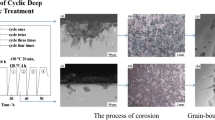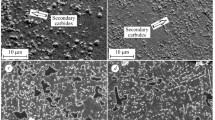Abstract
An attempt has been made to evaluate the effect of deep cryogenic treatment on the corrosion resistance of rebar. Corrosion behavior of samples subjected to deep cryogenic treatment and samples tempered after deep cryogenic treatment was studied by linear polarization method. The Vickers hardness and ultimate tensile strength of the samples were also measured. The possible mechanism for increase in corrosion resistance has been explained based on Scanning electron micrographs (SEM) and X-Ray diffraction (XRD) study. The morphology of the corroded surfaces of the samples was studied using Atomic force microscopy (AFM). It was found that there is 69 % improvement in corrosion resistance because of deep cryogenic treatment, further it was seen that the increase in corrosion resistance was due to the contribution of increased pearlite phase. Deep cryogenic treatment had no adverse effect on ultimate tensile strength and hardness, which are crucial properties to be considered for rebar.
Similar content being viewed by others
References
I. L. Al-Qadi, J. E. Peterson and R. E. A. Weyers, Time to cracking model for critically contaminated reinforced concrete structures, Proc. Fifth Int. Conf: on Structural Faults and Repair, Edinburgh, UK (1993) 91–98.
S. J. Pantazopoulou and K. D. papoulia, Modeling covercracking due to reinforcement corrosion in RC structures, J. Eng. Mech., 127 (4) (2001) 342–351.
K. lundgren, Modelling the effect of corrosion on bond in reinforced concrete, Mag. Concr. Res., 54 (3) (2002) 165–173.
K. Bhargava, A. K. Ghosh, Y. Mori and S. Ramanujam, Modeling of time to corrosion-induced cover cracking in reinforced concrete structures, Cem. Concr. Res., 35 (2005) 2203–2218.
H. M. Shodja, K. Kiani and A. Hashemian, A model for the evolution of concrete deterioration due to reinforcement corrosion, Math. Comput. Modell., 52 (2010) 1403–1422.
K. Kiani and H. M. Shodja, Prediction of the penetrated rust into the microcracks of concrete caused by reinforcement corrosion, Appl. Math. Modell., 35 (2011) 2529–2543.
K. Kiani and H. M. Shodja, Response of reinforced concrete structures to macrocell corrosion of reinforcement, Part I: Before propagation of microcracks via an analytical approach, Nucl. Eng. Des., 241 (2011) 4874–4892.
K. Kiani and H. M. Shodja, Response of reinforced concrete structures to macrocell corrosion of reinforcement. Part I: After propagation of microcracks via a numerical approach, Nucl. Eng. Des., 242 (2012) 7–18.
A. A. Almusallam, Effect of degree of corrosion on the properties of reinforcing steel bars, Construct Build Mater., 15 (8) (2001) 361–368.
E. Zitrou, J. Nikolaou, P. E. Tsakiridis and G. D. Papadimitriou, Atmospheric corrosion of steel reinforcing bars produced by various manufacturing processes, Construct Build Mater., 21 (2007) 1161–1169.
V. Kumar, Protection of steel reinforcement for concrete-A review, Corros. Rev., 16 (4) (1988) 317–358.
B. Elsener, Corrosion rate of steel in concrete-measurements beyond the Tafel law, Corros. Sci., 47 (2005) 3019–3033.
B. Elsener, Macrocell corrosion of steel in concrete -implications for corrosion monitoring, Cement Concrete Comp, 24 (2002) 65–72.
S. Qian, J. Zhang and D. Qu, Theoretical and experimental study of microcell and macrocell corrosion in patch repairs of concrete structures, Cement Concrete Comp, 28 (2006) 685–695.
C. M. Hansson, A. Poursaee and A. Laurent, Macrocell and microcell corrosion of steel in ordinary Portland cement and high performance concretes, Cement Concrete Res, 36 (2006) 2098–2102.
P. Novak, R. Mala and L. Joska, Influence of pre-rusting on steel corrosion in concrete, Cement Concrete Res, 31 (2001) 589–593.
X. Fu and D. D. L. Chung, Effect of corrosion on the bond between concrete and steel rebar, Cement Concrete Res, 27 (12) (1997) 181l-1815.
O. Kayali and S. R. Yeomaus, Bond of ribbed galvanized reinforcing steel concrete, Cem. Concr Comp, 22 (2000) 459–467.
A. U. Malik, I. Andijani, S. Ahmed and A.-M. Fahd, Corrosion and mechanical behavior of fusion bonded epoxy (FBE) in aqueous media, Desalination, 150 (3) (2002) 247–254.
A. B. Darwin and J. D. Scantlebury, Retarding of corrosion processes on reinforcement bar in concrete with an FBE coating, Cem Concr Comp, 24 (1) (2002) 73–78.
S. Erdogdu, T. W. Bremner and I. L. Kondratova, Accelerated testing of plain and epoxy-coated reinforcement in simulated seawater and chloride solutions, Cem Concr Res, 31 (6) (2001) 861–867.
R. F. Barron and R. H. Thompson, Effect of cryogenic treatment on corrosion resistance, Advances in Cryogenic Engineering Materials, 36 (1990) 1375–1379.
S. K. Putatunda, Fracture toughness of a high carbon and high silicon steel, Mater. Sci. Eng. A, 297 (2001) 31–43.
D. Das, R. Sarkar, A. K. Dutta and K. K. Ray, Influence of sub-zero treatments on fracture toughness of AISI D2 steel, Mater. Sci. Eng. A, 528 (2010) 589–603.
S. Zhirafar, A. Rezaeian and M. Pugh, Effect of cryogenic treatment on the mechanical properties of 4340 steel, J. Mater. Process. Technol, 186 (2007) 298–303.
S. Harish, A. Bensely, D. M. Lal, A. Rajadurai and G. B. Lenkey, Microstructural study of cryogenically treated En31 bearing steel, J. Mater. Proc. Technol., 209 (2009) 3351–3357.
D. N. Collins and J. Dormer, Deep cryogenic treatment of a D2 cold-worked tool steel, Heat Treat. Met., 24 (3) (1997) 71–74.
D. Senthilkumar, I. Rajendran, M. Pellizzari and J. Siiriainen, Influence of shallow and deep cryogenic treatment on the residual state of stress of 4140 steel, J. Mater. Process. Technol., 211 (2011) 396–401.
K. P. Kollmer, Applications & developments in the cryogenic processing of materials, The Technology Interface. Electronic Journal for Engineering Technology, 3 (1) (1999).
Z. Zhu, J. Zhao and X. Huang, Effects of cryotreat on the corrosion resistance of the medium melting point castable alloy, West China Journal of Stomatology, 20 (5) (2002) 316–319.
A. Akhbarizadeh, K. Amini and S. Javadpour, Effects of applying an external magnetic field during the deep cryogenic heat treatment on the corrosion resistance and wear behavior of 1.2080 tool steel, Mater Design, 41 (2012) 114–123.
Q.-Q. Wang, W.-Z. Wang, F.-Z. Xuan and S.-T. Tu, A new method improving intergranular corrosion resistance of AISI 304 stainless steel, FM2008 -Evaluation, Inspection and Monitoring of Structural Integrity (2008) 411–416.
ASTM standard E92-82, Standard test method for Vickers hardness of metallic materials, Annual book of standards (2004).
ASTM standard A370-03a, Standard Test Methods and Definitions for Mechanical Testing of Steel Products, Annual book of standards (2004).
ASTM standard G3-89, Standard Practice for Conventions Applicable to Electrochemical Measurements in Corrosion Testing, Annual book of standards (2004).
ASTM standard E975-03, Standard Practice for X-Ray Determination of Retained Austenite in Steel with Near Random Crystallographic Orientation, Annual book of standards (2004).
R. Abedinzadeh, S. M. Safavi and F. Karimzadeh, A study of pressureless microwave sintering, microwave-assisted hot press sintering and conventional hot pressing on properties of aluminium/alumina nanocomposite, Journal of Mechanical Science and Technology, 30 (5) (2016) 1967–1972.
A. Kamboj, S. Kumar and H. Singh, Burr height and hole diameter error minimization in drilling of AL6063/15%/SiC composites using HSS step drills, Journal of Mechanical Science and Technology, 29 (7) (2015) 2837–2846.
M. Ferhat, A. Benchettara, S. E Amara and D. Najjar, Corrosion behaviour of Fe-C alloys in a sulfuric medium, J. Mater. Environ. Sci., 5 (4) (2014)1059–1068.
J. Mazur, Investigation on austenite and martensite subjected to very low temperatures, Cryogenics, 4 (1964) 36.
M. G. Fontana, Corrosion engineering, Tata McGraw-Hill, New Delhi, India, 36 (2005) 1375–1379.
S. Kalia, C. Processing: A study of materials at low temperatures, J. Low Temp. Phys, 158 (2010) 934–945.
H. Yumoto, Y. Nagamine, J. Nagahama and M. Shimotomai, Corrosion and stability of cementite films prepared by electron shower, Vacuum, 65 (2002) 527–531.
Author information
Authors and Affiliations
Corresponding author
Additional information
Recommended by Associate Editor In-Ha Sung
Srinivasagam Ramesh is presently working as Teaching Fellow in the Department of Mechanical Engineering, Anna University, Chennai, India. He obtained his Master of Engineering from Alagappa Chettiar College of Engineering & Technology, Karaikudi, India. His field of research interests include corrosion, cryogenics treatments for materials, material characterization, and optimization.
B. Bhuvaneshwari worked as a Adhoc Scientist at CSIR- Structural Engineering Research Centre (CSIR- SERC), Chennai India and has more than 6 years of Research and Development experience. Her field of research interests include advanced composite materials, corrosion of metals, polymer synthesis and functional materials characterization. She has published more than 15 papers in various referred international and national journals, more than 40 papers in various Conference/ Seminar/Workshop proceedings.
G. S. Palani is presently a Chief Scientist at CSIR-Structural Engineering Research Centre (CSIR-SERC), Chennai, India and has Research and Development experience of more than 25 years. His field of research interest include advanced finite element analysis, computational Structural dynamics, fatigue and fracture analysis, steel structures analysis, design & testing and material science. He has published over 60 papers in various refereed international and national journals, more than 110 papers in various Conference/Seminar/Workshop proceedings. He has 4 copyrights of software and 3 proceedings volumes to his credit.
D. Mohan Lal is currently a Professor at the Department of Mechanical Engineering, Anna University, Chennai, India. He has been working in the field of Refrigeration for the past 25 years and has guided many M.E. Theses and 12 Ph.Ds. He has published 63 research papers in international journals focusing on heat transfer characteristics of refrigerants, heat transfer in nanofluids, performance assessment of refrigeration system.
Nagesh R. Iyer is presently a Distinguished Professor in Academy of Scientific & Innovative Research (AcSIR) and former Director of CSIR-Structural Engineering Research Centre (CSIRSERC), Chennai and the Coordinating Director of CSIR Madras Complex. He has over 35 years of experience in the areas of Computational Structural Mechanics, Fatigue, Fracture Mechanics, Damage Mechanics, Damage Tolerance, performance evaluation & condition monitoring of structures and Structure-Interaction studies. He has published over 130 papers in national & international journals, over 175 papers at the national & internal conferences and 4 patents.
Rights and permissions
About this article
Cite this article
Ramesh, S., Bhuvaneswari, B., Palani, G.S. et al. Effects on corrosion resistance of rebar subjected to deep cryogenic treatment. J Mech Sci Technol 31, 123–132 (2017). https://doi.org/10.1007/s12206-016-1211-5
Received:
Revised:
Accepted:
Published:
Issue Date:
DOI: https://doi.org/10.1007/s12206-016-1211-5




